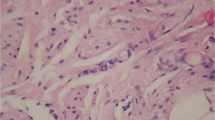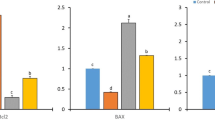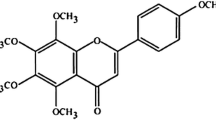Abstract
Breast cancer is the principle cause of death among women worldwide. In this study, we investigated the anti-tumor potential of lycopene (Lyco) alone or combined with melatonin (Lyco + Mel) for 120 days against a single oral dose of (50 mg/kg B.W.) 7,12-dimethylbenz(a)anthracene (DMBA)-induced oxidative stress and mammary carcinogenesis in female rats. The treatment protocol started from the day immediately after DMBA administration. Results obtained indicated that there was an elevation in the levels of malondialdhyde and nitric oxide in serum and breast tissues of DMBA injected rats. The combined treatment (Lyco + Mel) group showed a potential reduction of these parameters more than lyco individually. The activities of SOD, CAT, and GPx were found to be significantly high than lyco alone treated rats. In DMBA group a negative significant correlation between weight and serum nitric oxide (r = −0.59), and a positive significant correlation between NO and MDA (r = 0.81) was observed. Histopathological examination revealed the formation of tumor and angiogenesis in DMBA-induced rats and these abnormal changes were ameliorated by combined treatment with Lyco + Mel. In conclusion, these results suggested that supplementation of diet with lycopene with melatonin provided antioxidant defense with strong chemo preventive activity against DMBA-induced mammary tumors.

Similar content being viewed by others
References
Bray F, McCarron P, Parkin DM (2004) The changing global patterns of female breast cancer incidence and mortality. Breast Cancer Res 6:229–239. doi:10.1186/bcr932
Aruoma OI (1994) Nutrition and health aspects of free radicals and antioxidants. Food Chem Toxicol 32:671–685. doi:10.1016/0278-6915(94)90011-6
Cerutti PA (1985) Prooxidant states and tumor promotion. Science 227:375–381. doi:10.1126/science.2981433
Jagetia GC, Rao SK (2006) Evaluation of the antineoplastic activity of guduchi (Tinospora cordifolia) in Ehrlich ascites carcinoma bearing mice. Biol Pharm Bull 29:460–466. doi:10.1248/bpb.29.460
Vijayavel K, Anbuselvam C, Balasubramanian MP (2006) Free radical scavenging activity of the marine mangrove Rhizophora apiculata bark extract with reference to naphthalene induced mitochondrial dysfunction. Chem Biol Int 163:170–175. doi:10.1016/j.cbi.2006.06.003
Rao V, Agarwal S (1999) Role of lycopene as antioxidant carotenoids in the prevention of chronic diseases: a review. Nutr Res 19(2):305–323. doi:10.1016/S0271-5317(98)00193-6
Joseph BG, Michael C, Wieslawa K, Seth T, Zhonglin Z, Leonard AC (2001) Effects of a lycopene-rich diet on spontaneous and benzo[a]pyrene-induced mutagenesis in prostate, colon and lungs of the lacZ mouse. Cancer Lett 164:1–6. doi:10.1016/S0304-3835(00)00705-9
Gerster H (1997) The potential role of lycopene for human health. J Am Coll Nutr 16:109–126
Clinton SK (1998) Lycopene: chemistry, biology, and implications for human health and disease. Nutr Rev 56:35–51
Fuhramn B, Elis A, Aviram M (1997) Hypocholesterolemic effect of lycopene and ß-carotene is related to suppression of cholesterol synthesis and augmentation of LDL receptor activity in macrophage. Biochem Biophys Res Commun 233:658–662. doi:10.1006/bbrc.1997.6520
Hussein MR, Abu-Dief EE, Abdel Reheem MH, Abdel Rahman A (2005) Ultra structural evaluation of the radio protective effects of melatonin against X-ray induced skin damage in Albino rats. Int J Exp Pathol 86:45–55. doi:10.1111/j.0959-9673.2005.00412.x
Reiter MH, Tan DX, Cabrera J et al (1999) The oxidant/antioxidant network; role of melatonin. Biol Signals Recept 8:56–63. doi:10.1159/000014569
Maestroni GJ, Conti A (1989) Beta-endorphin and dynorphin mimic the circadian immunoenhancing and anti-stress effects of melatonin. Int J Immunopharmacol 11:333–340. doi:10.1016/0192-0561(89)90078-7
Astrog P, Gradelet S, Berges R, Suschetet M (1997) Dietary lycopene decreases initiation of liver preneoplastic foci by diethylnitrosamine in rat. Nutr Cancer 29:60–65
Henry L, Narendra PS (2006) Oral artemisinin prevents and delays the development of 7,12-dimethylbenz[a]anthracene (DMBA)-induced breast cancer in the rat. Cancer Lett 231:43–44. doi:10.1016/j.canlet.2005.01.019
Delphine G, Bernard L, Jérémie T, Andrzej M, Stéphane G, Catherine C, Edmond R (2007) Serum from rats fed red or yellow tomatoes induces Connexin43 expression independently from lycopene in a prostate cancer cell line. Biochem Biophys Res Commun 364:578–582. doi:10.1016/j.bbrc.2007.10.030
Mohamed AM, Hosny AH, Mahmoud HM, Abdelreheim AA, Sary KH, Mhmoud RH (2005) The biochemical and morphological alterations following administration of melatonin, retinoic acid and nigella sativa in mammary carcinoma: an animal model. Int J Exp Pathol 86:383–396. doi:10.1111/j.0959-9673.2005.00448.x
Vodovotz Y (1996) Modified microassay for serum nitrite and nitrate. Biotechniques 20(3):390–394
Zima T, Stipek S, Crkovska J, Platenik J (1995) Measurement of lipid peroxidation products in biological samples by spectrophotometric and HPLC assay. Klin Biochem Metab 3(24):98–102
Flohe L, Otting F (1984) Superoxide dismutase assays. Methods Enzymol 105:93. doi:10.1016/S0076-6879(84)05013-8
Claiborne A (1985) Catalase activity. In: Greenwald RA (ed) CRC handbook of methods for oxygen radical research. CRC Press, Boca Raton, pp 283–284
Ellman GL (1959) Tissue sulfhydryl groups. Arch Biochem Biophys 82:70–77. doi:10.1016/0003-9861(59)90090-6
Costa I, Solanas M, Escrich E (2002) Histopathologic characterization of mammary neoplastic lesions induced with 7,12-dimethylbenz(a)anthracene in the rat. A comparative analysis with human breast tumor. Arch Pathol Lab Med 126:915–927
Ramar PS, Ponnampalam G, Savarimuthu I (2006) Anti-tumor promoting potential of luteolin against 7,12-dimethylbenz(a)anthracene-induced mammary tumors in rats. Chem Biol Interact 164:1–14. doi:10.1016/j.cbi.2006.08.018
Mehta RG (2000) Experimental basis for the prevention of breast cancer. Eur J Cancer 36:1275–1282. doi:10.1016/S0959-8049(00)00100-3
Giri U, Sharma SD, Abdulla M, Athar M (1995) Evidence that in situ generated reactive oxygen species act as a potent stage I tumor promoter in mouse skin. Biochem Biophys Res Commun 209(2):698–705. doi:10.1006/bbrc.1995.1555
Davis L, Kuttan G (2001) Effect of Withania somnifera on DMBA induced carcinogenesis. J Ethnopharmacol 75:165–168. doi:10.1016/S0378-8741(00)00404-9
Huang YL, Sheu JY, Lin TH (1999) Association between oxidative stress and changes of trace elements in patients with breast cancer. Clin Biochem 32:31–36. doi:10.1016/S0009-9120(98)00096-4
Weydert CJ, Waugh TA, Ritchie JM, Iyer KS, Smith JL, Li L, Spitz DR, Oberley LW (2006) Overexpression of manganese or copper-zinc superoxide dismutase inhibits breast cancer growth. Free Radic Biol Med 41:226–237
Gonenc A, Erten D, Aslan S, Akyncy M, Simşek B, Torun M (2006) Lipid peroxidation and antioxidant status in blood and tissue of malignant breast tumour and benign breast disease. Cell Biol Int 30:376–380. doi:10.1016/j.cellbi.2006.02.005
Cerutti P, Ghosh R, Oya Y, Amstad P (1994) The role of cellular antioxidant defence in oxidant carcinogenesis. Environ Health Perspect 102(10):123–129. doi:10.2307/3432228
Bewick M, Coutie W, Tudhope GR (1987) Superoxide dismutase, glutathione peroxidase and catalase in the red cells of patients with malignant lymphoma. Br J Haematol 65:347–350. doi:10.1111/j.1365-2141.1987.tb06866.x
Cohen M, Lippman M, Chabner B (1978) Role of pineal gland in aetiology and treatment of breast cancer. Lancet 2:814–816. doi:10.1016/S0140-6736(78)92591-6
Tamarkin L, Cohen M, Roselle D, Reichert C, Lippman M, Chabner B (1981) Melatonin inhibition and pinealectomy enhancement of 7,12-dimethylbenz(a)anthracene-induced mammary tumors in the rat. Cancer Res 41(11):4432–4436
Acknowledgment
The authors would like to thank prof. Dr. Taha Kumosani, Head of Biochemistry Dep., Faculty of Science, KAU, Jeddah, KSA for his kind facilitation of supplies for this work.
Author information
Authors and Affiliations
Corresponding author
Rights and permissions
About this article
Cite this article
Moselhy, S.S., Al mslmani, M.A.B. Chemopreventive effect of lycopene alone or with melatonin against the genesis of oxidative stress and mammary tumors induced by 7,12 dimethyl(a)benzanthracene in sprague dawely female rats. Mol Cell Biochem 319, 175–180 (2008). https://doi.org/10.1007/s11010-008-9890-6
Received:
Accepted:
Published:
Issue Date:
DOI: https://doi.org/10.1007/s11010-008-9890-6




